As a protracted armed conflict spanning more than seven decades, the internal conflict in Myanmar has involved over fifty different armed groups, three military juntas, and seven civilian-led governments.
As a protracted armed conflict spanning more than seven decades, the internal conflict in Myanmar has involved over fifty different armed groups, three military juntas, and seven civilian-led governments.
| Ethnic armed organisations | |
|---|---|
|
|
| Ethnic armed organisations | |
|---|---|
|
|
| Ethnic armed organisations | |
|---|---|
|
|
| Ethnic armed organisations | |
|---|---|
|
|
and ethnic armed organisations | |
|---|---|
|
|
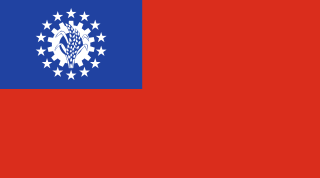
The State Peace and Development Council was the official name of the military government of Burma (Myanmar) which, in 1997, succeeded the State Law and Order Restoration Council that had seized power under the rule of Saw Maung in 1988. On 30 March 2011, Senior General and Council Chairman Than Shwe signed a decree that officially dissolved the council.

The Myanmar Air Force, known until 1989 as the Burmese Air Force, is the aerial branch of Myanmar's armed forces, the Tatmadaw. The primary mission of the Myanmar Air Force (MAF) since its inception has been to provide transport, logistical, and close air support to the Myanmar Army in counter-insurgency operations. It is mainly used in internal conflicts in Myanmar, and, on a smaller scale, in relief missions, especially after the deadly Cyclone Nargis of May 2008.

Insurgencies have been ongoing in Myanmar since 1948, the year the country, then known as Burma, gained independence from the United Kingdom. The conflict has largely been ethnic-based, with several ethnic armed groups fighting Myanmar's armed forces, the Tatmadaw, for self-determination. Despite numerous ceasefires and the creation of autonomous self-administered zones in 2008, many armed groups continue to call for independence, increased autonomy, or the federalisation of the country. The conflict is the world's longest ongoing civil war, having spanned more than seven decades.

The Pa-O National Organisation is a Pa-O political party in Myanmar (Burma). Its armed wing, the Pa-O National Army, has between 400 and 700 active personnel. The PNO administers the Pa-O Self-Administered Zone, which consists of three townships in southern Shan State: Hopong, Hsi Hseng, and Pinlaung townships.

The Kachin conflict or the Kachin War is one of the multiple conflicts which are collectively referred to as the internal conflict in Myanmar. Kachin insurgents have been fighting against the Tatmadaw since 1961, with only one major ceasefire being brokered between them, which lasted from 1994 to 2011, a total of 17 years.
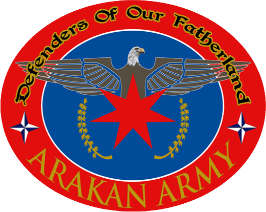
The Arakan Army, officially the Arakha Army is an ethnic armed organisation based in Rakhine State (Arakan). Founded on 10 April 2009, the AA is the military wing of the United League of Arakan (ULA). It is currently led by Commander-in-Chief Major General Twan Mrat Naing and vice deputy commander-in-chief Brigadier General Nyo Twan Awng. The Arakan Army states that the objective of its armed revolution is to restore the sovereignty of the Arakan people. In a February 2024 interview, Twan Mrat Naing claimed that the AA had grown to at least 38,000 troops. Anthony Davis, an expert of military and security, rejected this claim and estimated that it has at least 15,000 troops in Chin State and Rakhine State, in addition to around 1500 in Kachin State and Shan State. In the early 2010s, the Arakan Army fought alongside the Kachin Independence Army (KIA) against the Tatmadaw in the Kachin conflict. Following the 2016 outbreak of conflict in Rakhine state, AA became more heavily involved in the Arakan region. In 2019, AA would launch attacks on state security forces and the Myanmar Army would respond heightening clashes. The AA reached a ceasefire in late 2020 after eroding the central government's control in northern Rakhine. The power vacuum would be filled by the AA over the next 18 months with state-building efforts, like their COVID-19 vaccine rollouts.

The Myanmar National Democratic Alliance Army (MNDAA) is an armed resistance group in the Kokang region of Myanmar (Burma). The army has existed since 1989, having been the first one to sign a ceasefire agreement with the Burmese government. The ceasefire lasted for about two decades.
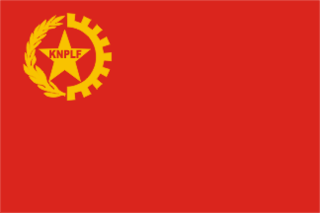
The Karenni National People's Liberation Front (KNPLF) is a communist and Karenni nationalist insurgent group active in Kayah State, Myanmar (Burma). It agreed to become a government-sponsored border guard force on 8 November 2009 although it remains active under the name of KNPLF. Starting from 13 June 2023, it has decided to change sides to the Karen National Liberation Army (KNLA), Karenni Army (KA), Karenni Nationalities Defense Force (KNDF), and People's Defense Force (PDF) and fight the military regime.
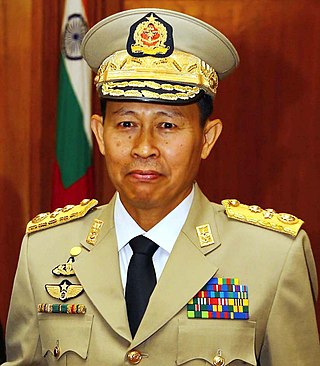
Soe Win is a Burmese army general and the current Deputy Prime Minister of Myanmar. Appointed following the formation of the caretaker government on 1 August 2021, Soe Win hold essential roles, including Vice Chairman of the State Administration Council (SAC), Deputy Commander-in-Chief of the Tatmadaw, and Commander-in-Chief of the Myanmar Army. He is also a member of Myanmar's National Defence and Security Council (NDSC). In May 2012, former President of Myanmar, Thein Sein appointed Soe Win to the working committee of the government team responsible for negotiating with Myanmar's many armed ethnic rebel groups. He is a close associate of former Vice Chairman of the State Peace and Development Council (SPDC), Vice-Senior General Maung Aye.
Violent clashes have been ongoing in the northern part of Myanmar's Rakhine State since October 2016. Insurgent attacks by the Arakan Rohingya Salvation Army (ARSA) have led to sectarian violence perpetrated by Myanmar's military and the local Buddhist population against predominantly Muslim Rohingya civilians. The conflict has sparked international outcry and was described as an ethnic cleansing by the United Nations High Commissioner for Human Rights. In August 2017, the situation worsened and hundreds of thousands of refugees fled Myanmar into Bangladesh, with an estimated 500,000 refugees having arrived by 27 September 2017. In January 2019, Arakan Army insurgents raided border police posts in Buthidaung Township, joining the conflict and beginning their military campaign in northern Rakhine State against the Burmese military.

The Shanni Nationalities Army is a Shanni insurgent group active in northern Sagaing Region and Kachin State, Myanmar (Burma). It was founded as a group in 1989 but was transformed into an armed group in January 2016 by expelled Shanni members of the Kachin Independence Army. The SNA has five objectives – to gain statehood, to fight drugs, to establish a federal Union, to build unity among all Shan sub-groups, and to conserve ecological balance.

The People's Defence Force is the armed wing of the National Unity Government in Myanmar. The armed wing was formed by the NUG from youths and pro-democracy activists on 5 May 2021 in response to the coup d'état that occurred on 1 February 2021 that put the military junta and their armed wing the Tatmadaw in power. The military junta designated it as a terrorist organisation on 8 May 2021. In October 2021, NUG's Ministry of Defence announced that it had formed a central committee to coordinate military operations across the country.

The Myanmar civil war, also called the Burmese Spring Revolution, Burmese civil war or People's Defensive War, is an ongoing civil war following Myanmar's long-running insurgencies, which escalated significantly in response to the 2021 military coup d'état and the subsequent violent crackdown on anti-coup protests. The exiled National Unity Government and major ethnic armed organisations repudiated the 2008 Constitution and called instead for a democratic federal state. Besides engaging this rebel alliance, the junta also contends with other anti-junta forces in areas under its control. Hannah Beech of The New York Times observed the insurgents are apportioned into hundreds of armed groups scattered across the country.

The Chinland Defense Force is a rebel group in Myanmar. It was formed in response to the 2021 Myanmar coup d'état to protect Chin State from the military junta. The CDF claims that they do not attack the military without cause and that they always issue a warning, such as releasing detainees and refraining from using violence against civilians. If the military does not respond, guerrilla or other action follows. They promise to return their weapons and disband if the revolution is successful. CDFs are members of CJDC. Chinland Joint Defense Committee (CJDC) is formed to serve Chin people's security services and protect an enemy from the illegal Myanmar Army. The total strength of active personnel under the command of CJDC is approximated to be around 15,000. From August to October 2021, it was reported that at least 40 clashes occurred between junta troops and CDF in various townships. CJDC claimed that at least 1,029 Tatmadaw soldiers were killed in the clashes and lost 58 of their own in 2021.

The Karenni Nationalities Defence Force is an armed insurgent group in Myanmar formed in response to the 2021 Myanmar coup d'état. The KNDF also includes other organizations, such as the KNPP, which an official regard as "good relations between the EAOs and the public" The KNDF has engaged in fighting with the junta, mainly with the 66th Light Infantry Division.
Events in the year 2022 in Myanmar.
The following is a timeline of major events during the Myanmar civil war (2021–present), following the 2021 military coup d'état and protests. It was also a renewed intensity in existing internal conflict in Myanmar.
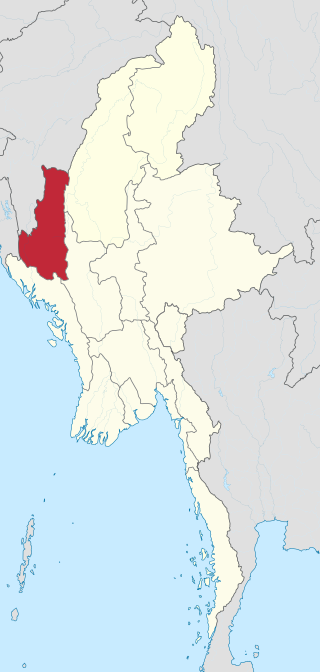
The Chin theater is one of the theaters of the Myanmar civil war (2021–present), with resistance forces fighting against the Tatmadaw military junta in Chin State, western Myanmar.

The Dry Zone theater, also known as the Anyar theater, is one of the theaters of the Myanmar civil war (2021–present), taking place in Myanmar's Dry Zone region which encompasses the Bamar-majority Sagaing, Magway and Mandalay regions. It has been described as the "prime center" of resistance against the junta.